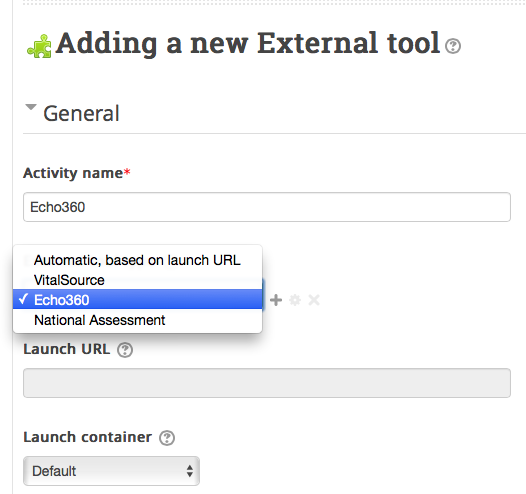Activities - Database - TemplatesTemplates are how the database looks on your Moodle page. There are three main templates you need to worry about:
All others can be left on their default settings. List view This is the default view when people first arrive in the database activity. It shows multiple entries, usually stacked vertically one after the other. If there are a lot of entries in the database, and the entries are long, it may be worth making this a reduced view (with just a title and entry author) which can click through to the single entry. Single entry view This shows just a single database entry. It will contain all the information. Add template This determines what the page looks like when a student (or teacher) adds a new entry to the database. It will also contain all the possible fields for the participant to fill out, laid out in a way and order that makes sense. |
Activities - External ToolThe external tool activity module enables students to interact with learning resources and activities on other web sites. For example, an external tool could provide access to a new activity type or learning materials from a publisher. For example, to Add Echo360 activity, you can select "Echo360' from the 'External too type' drop down menu:
|
Activities - ForumThe forum activity module enables participants to have asynchronous discussions i.e. discussions that take place over an extended period of time. There are several forum types to choose from, such as a standard forum where anyone can start a new discussion at any time; a forum where each student can post exactly one discussion; or a question and answer forum where students must first post before being able to view other students' posts. A teacher can allow files to be attached to forum posts. Attached images are displayed in the forum post. Participants can subscribe to a forum to receive notifications of new forum posts. A teacher can set the subscription mode to optional, forced or auto, or prevent subscription completely. If required, students can be blocked from posting more than a given number of posts in a given time period; this can prevent individuals from dominating discussions. Forum posts can be rated by teachers or students (peer evaluation). Ratings can be aggregated to form a final grade which is recorded in the gradebook. Forums have many uses, such as
|
Activities - GlossaryThe glossary activity module enables participants to create and maintain a list of definitions, like a dictionary, or to collect and organise resources or information. A teacher can allow files to be attached to glossary entries. Attached images are displayed in the entry. Entries can be searched or browsed alphabetically or by category, date or author. Entries can be approved by default or require approval by a teacher before they are viewable by everyone. If the glossary auto-linking filter is enabled, entries will be automatically linked where the concept words and/or phrases appear within the course. A teacher can allow comments on entries. Entries can also be rated by teachers or students (peer evaluation). Ratings can be aggregated to form a final grade which is recorded in the gradebook. Glossaries have many uses, such as |
Activities - HotPotThe HotPot module allows teachers to distribute interactive learning materials to their students via Moodle and view reports on the students' responses and results. A single HotPot activity consists of an optional entry page, a single elearning exercise, and an optional exit page. The elearning exercise may be a static web page or an interactive web page which offers students text, audio and visual prompts and records their responses. The elearning exercise is created on the teacher's computer using authoring software and then uploaded to Moodle. A HotPot activity can handle exercises created with the following authoring software: Hot Potatoes (version 6)
|
